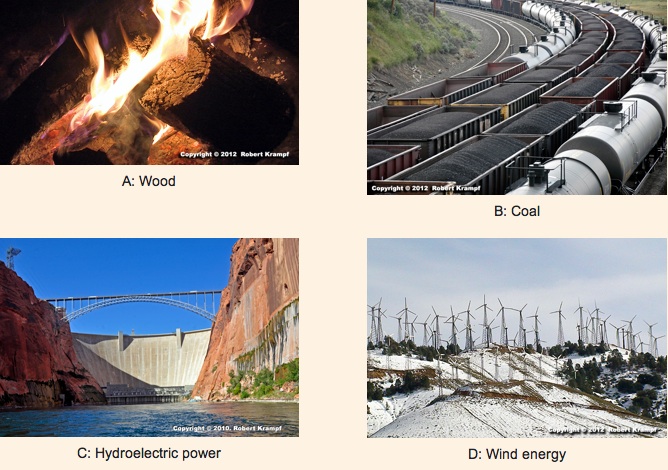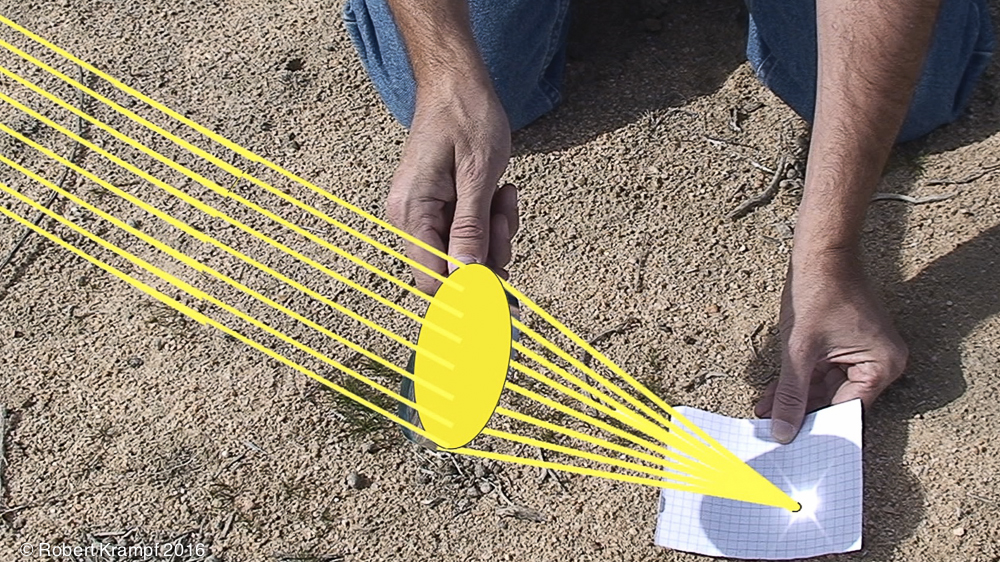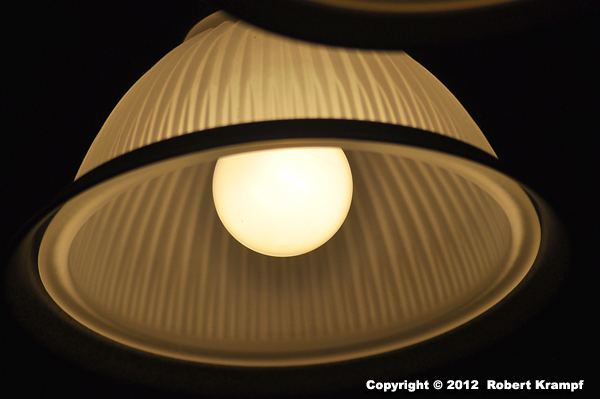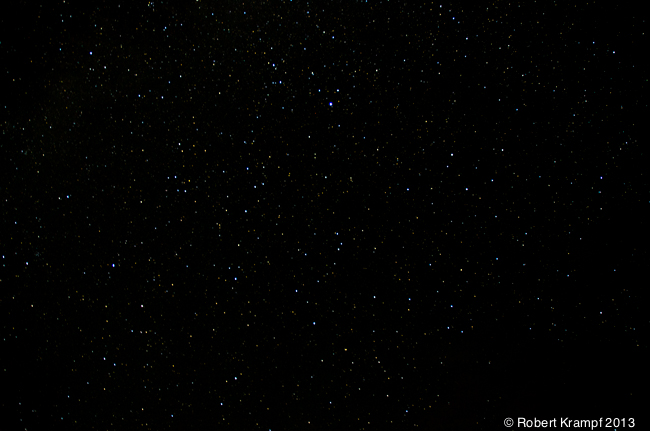Here are some science questions from the Standards for Grades 2-5 to help you test your knowledge of the Next Generation Sunshine State Standards.
The questions are chosen randomly, so this quest will be different each time you reload the page.
* Click here to see only the most recently added questions.

Which of these is NOT an example of a renewable energy source?
-
Wood
No. Because we can grow more trees, wood is a renewable energy source. -
Coal
Yes. It takes millions of years for coal to form, so it is not considered a renewable energy source. -
Hydroelectric power
No. Thanks to the water cycle, water is added to the lake above the dam, making this a renewable energy source. -
Wind energy
No. Wind energy is constantly renewed by uneven heating of the Earth.
Click to see which state standards this question tests, and which of my videos, experiments, and other resources support that topic.
Florida
SC.4.E.6.3 Recognize that humans need resources found on Earth and that these are either renewable or nonrenewable.
| Recycle | video |
| Review Energy-4 | quest |
| Review Energy-1 | practice |
Utah
NGSS
4-ESS3-1 Obtain and combine information to describe that energy and fuels are derived from natural resources and their uses affect the environment.
| Investigating Acid Rain | video, checked |
| Solar Power | video, checked |
| Review Energy-4 | quest |
| Review Energy-1 | practice |
5-ESS3-1 Obtain and combine information about ways individual communities use science ideas to protect the Earth’s resources and environment.
| Recycle | video |
| Review Energy-4 | quest |

The yellow lines show how light is bent as it passes through a magnifying glass. This is an example of:
-
Absorption
No. The glass is clear, telling us that very little of the light is being absorbed. Absorption does not bend the light. -
Diffusion
No. Diffusion is the scattering of light as it is reflected in many different directions. Diffusion would make the rays of light go in many different directions. -
Refraction
Yes! Refraction bends light as it moves from one substance to another. As the light passes through the curved lens of the magnifying glass its path is changed, bending the rays towards the focal point. -
Reflection
No. While some light is reflected from the glass, it is not responsible for the bending of the light.
Click to see which state standards this question tests, and which of my videos, experiments, and other resources support that topic.
Florida
SC.3.P.10.3 Demonstrate that light travels in a straight line until it strikes an object or travels from one medium to another.
| Changing the Speed of Light | video |
| Why is Foam White? | video, checked |
| Microscopes: Growing Crystals | video, free, learnalong, Updated |
| Sunglass Science: Birefringence | video, free, Updated |
| Sunglass Science: Polarized Light | video, free, Updated |
| Mirage | video, free, ClosedCaptions, Updated |
| Pinhole Eyeglasses | video, checked |
| Why Wet Things Turn Dark | video, checked |
| Growing Crystals Under the Microscope | video, free, learnalong, checked |
| A Long Lens | text page |
| Review Light-2 | practice |
| Review Light-3 | practice |
| Review Light-4 | practice |
| Review Light-5 | practice |
| Review Light-1 | practice |
SC.3.P.10.4 Demonstrate that light can be reflected, refracted, and absorbed.
| Changing the Speed of Light | video |
| Why is Foam White? | video, checked |
| Onion Crystals | video |
| Microscopes: Growing Crystals | video, free, learnalong, Updated |
| Sunglass Science: Birefringence | video, free, Updated |
| Sunglass Science: Polarized Light | video, free, Updated |
| Mirage | video, free, ClosedCaptions, Updated |
| Pinhole Eyeglasses | video, checked |
| Looking for Rainbows | video |
| Why Wet Things Turn Dark | video, checked |
| Growing Crystals Under the Microscope | video, free, learnalong, checked |
| A Long Lens | text page |
| Sunlight, Energy, and Crayons | text page, free |
| Review Light-2 | practice |
| Review Light-3 | practice |
| Review Light-4 | practice |
| Review Light-5 | practice |
| Review Light-1 | practice |
SC.7.P.10.2 Observe and explain that light can be reflected, refracted, and/or absorbed.
| Growing Crystals Under the Microscope | video, free, learnalong, checked |
| Finding Fat in Foods | video, ClosedCaptions, checked |
| Changing the Speed of Light | video |
| Onion Crystals | video |
| Why is Foam White? | video, checked |
| Microscopes: Growing Crystals | video, free, learnalong, Updated |
| Sunglass Science: Birefringence | video, free, Updated |
| Sunglass Science: Polarized Light | video, free, Updated |
| Mirage | video, free, ClosedCaptions, Updated |
| Pinhole Eyeglasses | video, checked |
| Why Wet Things Turn Dark | video, checked |
| A Long Lens | text page |
| Sunlight, Energy, and Crayons | text page, free |
| Review Light-2 | practice |
| Review Light-3 | practice |
| Review Light-4 | practice |
| Review Light-5 | practice |
| Review Light-1 | practice |
Utah
UT.8.IV.1.b Compare the transfer of energy (i.e., sound, light, earthquake waves, heat) through various mediums.
| Why Wet Things Turn Dark | video, checked |
| The Science of Pizza | video, checked |
| Heating a Balloon | video, ClosedCaptions, checked |
| Changing the Speed of Light | video |
| Doppler Effect | video, checked |
| Solar Power | video, checked |
| Sunglass Science: Birefringence | video, free, Updated |
| Sunglass Science: Polarized Light | video, free, Updated |
| Noisy String | video, checked |
| Mirage | video, free, ClosedCaptions, Updated |
| About Microwaves | video, checked |
| Microwave Chocolate | video, checked |
| Spoon Bells | video, checked |
| The Singing Glass | video, checked |
| Comparing How Sound Moves Through Liquids and Gases | text page |
| Review Light-2 | practice |
| Review Light-4 | practice |
| Review Light-5 | practice |
| Review Light-1 | practice |
NGSS
1-PS4-3 Plan and conduct an investigation to determine the effect of placing objects made with different materials in the path of a beam of light.
| Growing Crystals Under the Microscope | video, free, learnalong, checked |
| Sunprints | video |
| Changing the Speed of Light | video |
| Why is Foam White? | video, checked |
| Onion Crystals | video |
| Microscopes: Growing Crystals | video, free, learnalong, Updated |
| Sunglass Science: Birefringence | video, free, Updated |
| Sunglass Science: Polarized Light | video, free, Updated |
| Mirage | video, free, ClosedCaptions, Updated |
| A Color You Can't See | video, free, checked |
| Pinhole Eyeglasses | video, checked |
| Why Wet Things Turn Dark | video, checked |
| A Long Lens | text page |
| Review Light-2 | practice |
| Review Light-3 | practice |
| Review Light-4 | practice |
| Review Light-5 | practice |
| Review Light-1 | practice |
MS-PS4-2 Develop and use a model to describe that waves are reflected, absorbed, or transmitted through various materials.
| Onion Crystals | video |
| Sunprints | video |
| Finding Fat in Foods | video, ClosedCaptions, checked |
| Changing the Speed of Light | video |
| Why is Foam White? | video, checked |
| Sunglass Science: Birefringence | video, free, Updated |
| Sunglass Science: Polarized Light | video, free, Updated |
| Mirage | video, free, ClosedCaptions, Updated |
| About Microwaves | video, checked |
| Microwave Chocolate | video, checked |
| Why Wet Things Turn Dark | video, checked |
| A Long Lens | text page |
| Sunlight, Energy, and Crayons | text page, free |
| Review Light-2 | practice |
| Review Light-4 | practice |
| Review Light-5 | practice |
| Review Light-1 | practice |

Incandescent light bulbs use electrical energy to produce light energy, but it is not a direct transformation. Instead, the electrical energy is changed to a different form of energy, and then to light.
Electricity → ? → Light
What form of energy does the "?" represent?
-
Sound
No. Electrical energy can be transformed into sound energy, but that would not cause the bulb to light. -
Thermal
Yes. As electrical energy flows through the filament, resistance changes the electrical energy into thermal energy. When the filament gets hot enough, some of the thermal energy is converted into light. -
Radiation
No. The electrical energy is not transformed into radiation. -
Friction
No. The electrical energy is not transformed into friction.
Click to see which state standards this question tests, and which of my videos, experiments, and other resources support that topic.
Florida
SC.2.P.10.1 Discuss that people use electricity or other forms of energy to cook their food, cool or warm their homes, and power their cars.
| Review Energy-3 | practice |
SC.5.P.10.4 Investigate and explain that electrical energy can be transformed into heat, light, and sound energy, as well as the energy of motion.
| Introduction to the LED | video, checked |
| Light a Bulb with a Balloon | video, checked |
| Electricity | video, free, Updated |
| Review Energy-3 | practice |
SC.7.P.11.2 Investigate and describe the transformation of energy.
| The Rollback Can | video, free, Updated |
| High Bounce | video, checked |
| Review Energy-3 | practice |
Utah
UT.3.V.2.c Predict, measure, and graph the temperature changes produced by a variety of mechanical machines and electrical devices while they are operating.
| Review Energy-3 | practice |
UT.8.IV.4.b Trace the conversion of energy from one form of energy to another (e.g., light to chemical to mechanical).
| Measuring Kinetic and Potential Energy | video, checked |
| The Rollback Can | video, free, Updated |
| High Bounce | video, checked |
NGSS
4-PS3-4 Apply scientific ideas to design, test, and refine a device that converts energy from one form to another.
| Spoon Bells | video, checked |
| Ice Cream Science | video, checked |
| Making a Screamer | video, free, Updated |
| Measuring Kinetic and Potential Energy | video, checked |
| The Singing Glass | video, checked |
| The Slow Race | video, free, ClosedCaptions, Updated |
| Whistle Stick | video, text page, blog, free, checked |
| Simple Circuits | video, checked |
| Solar Power | video, checked |
| The Rollback Can | video, free, Updated |
| A Grass Whistle | video, checked |
| High Bounce | video, checked |
| Bottle Tones, part 1 | video, checked |
| Measuring Calories | video, ClosedCaptions, checked |
| Bottle Tones, part 2 | video, checked |
| Why Things Go Bang | video |
| Why We Sweat | video, checked |
| Sunglass Science: Birefringence | video, free, Updated |
| Sunglass Science: Polarized Light | video, free, Updated |
| Noisy String | video, checked |
| Sunlight, Energy, and Crayons | text page, free |
| Review Energy-5 | quest |
| Review Energy-3 | practice |

Which of the following is NOT a function of your skeleton?
-
Produce insulin
Yes! Insulin is produced by the pancreas, not by bones. -
Work with muscles to help you move
No. Your muscles attach to your bones. They work together to let you move. -
Protect internal organs
No. Your skull protects your brain. Your ribs protect your heart and lungs. Your backbone protects your spinal cord. -
Produce blood cells.
No. Your bone marrow produces your blood cells.
Click to see which state standards this question tests, and which of my videos, experiments, and other resources support that topic.
Florida
SC.2.L.14.1 Distinguish human body parts (brain, heart, lungs, stomach, muscles, and skeleton) and their basic functions.
| Bird Bones | video, free |
| Bendable Bones | video, checked |
| Reading a Skeleton | video, free, checked |
| Review Anatomy-1 | practice |
| Review Anatomy-2 | practice |
| Review Anatomy-3 | practice |
SC.5.L.14.1 Identify the organs in the human body and describe their functions, including the skin, brain, heart, lungs, stomach, liver, intestines, pancreas, muscles and skeleton, reproductive organs, kidneys, bladder, and sensory organs.
| Bird Bones | video, free |
| Kneesy, Earsy, Nosey | video, checked |
| Bendable Bones | video, checked |
| Just a Suggestion | video |
| Reaction Time | video |
| Reading a Skeleton | video, free, checked |
| Muscles Don't Push | text page |
| Review Anatomy-1 | practice |
| Review Anatomy-2 | practice |
| Review Anatomy-3 | practice |
SC.6.L.14.5 Identify and investigate the general functions of the major systems of the human body (digestive, respiratory, circulatory, reproductive, excretory, immune, nervous, and musculoskeletal) and describe ways these systems interact with each other to maintain homeostasis.
| Bird Bones | video, free |
| Bendable Bones | video, checked |
| Reaction Time | video |
| Reading a Skeleton | video, free, checked |
| Muscles Don't Push | text page |
| Review Anatomy-1 | practice |
| Review Anatomy-2 | practice |
| Review Anatomy-3 | practice |
Utah
UT.7.III.2.c Relate the structure of an organ to its component parts and the larger system of which it is a part.
| Reaction Time | video |
| Reading a Skeleton | video, free, checked |
| Review Anatomy-1 | practice |
| Review Anatomy-2 | practice |
| Review Anatomy-3 | practice |
NGSS
MS-LS1-3 Use argument supported by evidence for how the body is a system of interacting subsystems composed of groups of cells.
| Bird Bones | video, free |
| Bendable Bones | video, checked |
| Reaction Time | video |
| Reading a Skeleton | video, free, checked |
| Review Anatomy-1 | practice |
| Review Anatomy-2 | practice |
| Review Anatomy-3 | practice |

From our new home in Utah, the stars are so bright that we can even see the Milky Way Galaxy. How far is the Milky Way Galaxy from Earth?
-
923 light years.
-
92.3 light years.
-
9.23 light years.
-
We are in the Milky Way Galaxy.
Think about it, and when you think you know the answer, then continue.
The Sun and you and me and all the stars that we can see are in the galaxy we call the Milky Way.
923 light years.
92.3 light years.
9.23 light years.
We are in the Milky Way Galaxy.
Think about it, and when you think you know the answer, then continue.
The Sun and you and me and all the stars that we can see are in the galaxy we call the Milky Way.
Click to see which state standards this question tests, and which of my videos, experiments, and other resources support that topic.
Florida
SC.5.E.5.1 Recognize that a galaxy consists of gas, dust, and many stars, including any objects orbiting the stars. Identify our home galaxy as the Milky Way.
| Review Space-2 | practice |
| Review Space-1 | practice |
| Review Space-10 | practice |
SC.8.E.5.1 Recognize that there are enormous distances between objects in space and apply our knowledge of light and space travel to understand this distance.
| Sunprints | video |
| Making a Scale Model of the Solar System | video, ClosedCaptions |
| Global Science | video, ClosedCaptions |
| Sunglass Science: Birefringence | video, free, Updated |
| Sunglass Science: Polarized Light | video, free, Updated |
| A Color You Can't See | video, free, checked |
| How Far is That Planet? | text page |
| CD Spectrum | text page |
| Review Space-1 | practice |
| Review Light-3 | practice |
Utah
UT.6.IV.1.d Compare the size of the Milky Way galaxy to the size of the known universe.
| Review Space-1 | practice |
NGSS
2-LS2-1 Plan and conduct an investigation to determine if plants need sunlight and water to grow.
| Measuring Photosynthesis | video, checked |
| Testing a Leaf for Starch | video, ClosedCaptions |
| Review Plants-1 | practice |
